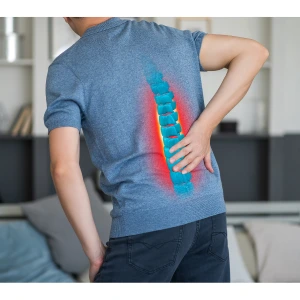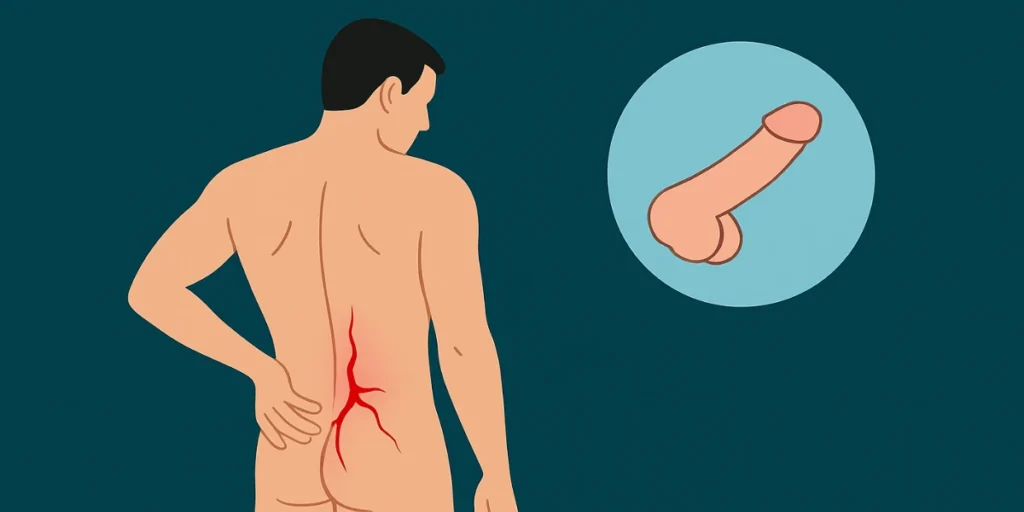Sciatica Impotence: Understanding the Link Between Sciatica and Erectile Dysfunction
Introduction
Sciatica—sharp, radiating pain along the path of the sciatic nerve—is a common complaint in men. Many assume it affects only the back and legs, but recent observations show that sciatica may also contribute to impotence or erectile dysfunction.
this post will help clarify how they may be linked, what causes there might be, how to diagnose the issue, and what treatments—including lifestyle changes—can help restore sexual health.
1. What Is Sciatica and Erectile Dysfunction?
Sciatica: Compression or irritation of one or more of the lumbar or sacral nerve roots (often L4, L5, S1) leading to symptoms like radiating leg pain, numbness, weakness, or tingling.
S1) leading to symptoms like radiating leg pain, numbness, weakness, or tingling.
Erectile Dysfunction (Impotence): The inability to achieve or maintain an erection sufficient for satisfactory sexual performance. It can have physical, neurological, psychological, or mixed causes.
2.Causes & Risk Factors: How Sciatica Might Lead to Impotence
Here are the possible mechanisms linking sciatica with erectile dysfunction, drawn from scientific and clinical sources:
| Mechanism | How It Works / Evidence |
| Nerve compression / radiculopathy | Severe lumbar disc herniation or spinal stenosis can compress nerve roots (including sacral/pudendal roots) that are crucial for penile sensation and erection. Sciatica may involve nerve roots that run close to or overlap with those involved in erectile function. |
| Reduced blood flow | Chronic inflammation, muscle spasms and nerve root compression may reduce vascular flow in the pelvic region necessary for erection. |
| Overlapping pelvic / genital nerve involvement | Some conditions that cause sciatica also affect nearby nerves (pudendal nerve, sacral roots) directly, thus possibly causing symptoms in genital area. |
| Chronic pain, stress, psychological factors | Persistent pain can lead to depression, anxiety, reduced sexual desire, performance anxiety—each of which can worsen or trigger erectile dysfunction. |
| Medication side effects | Drugs used to manage nerve pain (e.g. some anticonvulsants or muscle relaxants) may have side effects on sexual function. |
| Lifestyle and general health factors | Reduced mobility due to pain → less exercise, weight gain → cardiovascular risk factors → worsened ED. Smoking, obesity, poor sleep add risk. Some sciatica risk factors overlap ED risk factors. |
3.Risk factors that increase the chance of sciatica‐related impotence:
- Severe or chronic compression of lumbar/sacral nerve roots
- Delay in treatment of sciatica
- Co-existing vascular disease (diabetes, hypertension)
- Smoking, obesity, sedentary lifestyle
- Psychological stress, mental health issues
4.Symptoms / Signs That Suggest Sciatica-Related Impotence
If you have sciatica and suspect it is affecting sexual function, these signs may be clues:
- Numbness, tingling, or altered sensation in the genital, perineal or inner thigh areas

- Weakness or loss of control in muscles of lower back or pelvis
- Difficulty achieving or maintaining erection even when physically aroused
- Decreased libido potentially due to pain or psychological distress
- Pain during sexual activity, or worsened sciatic pain after sexual activity
- Onset of ED symptoms concurrent with sciatica exacerbation
5.Diagnosis / Tests
A thorough evaluation is essential; here’s how to approach it:
5.1 History and Physical Exam
- Detailed pain history: location, radiation, onset, severity, triggers
- Sexual history: onset, severity, pattern of ED; psychological factors
- Neurological exam: reflexes, muscle strength, sensory exam in lower back / sacral regions
5.2 Imaging
- MRI of lumbar and sacral spine to identify disc herniation, nerve compression, spinal stenosis.
- Possibly CT scan if MRI is contraindicated.
5.3 Nerve conduction / Electromyography (EMG)
- To assess nerve root function, particularly of sacral roots.
5.4 Vascular assessment
- Doppler ultrasound of penile arteries if vascular contribution suspected.
5.5 Lab tests
- Hormone profile (testosterone, prolactin)
- Blood sugar, lipid profile – to evaluate risk factors
5.6 Psychological evaluation
- Screening for depression, anxiety, stress.
6.Treatment Options
6.1 Oral medications
- Phosphodiesterase-5 inhibitors (PDE-5 inhibitors) like sildenafil, tadalafil, vardenafil. These are first-line treatments for ED of many causes.
6.2 Intracavernosal injections
- Drugs like papaverine, prostaglandin E1, phentolamine—injecting directly into penile tissue. Used especially when oral meds insufficient.
- Negative pressure devices that draw blood into the penis, often used when nerve or vascular function is impaired.
6.4 Penile prosthesis
- For refractory cases of ED where other treatments have failed.
6.5 Neurostimulation / neuromodulation
- Sacral neuromodulation and therapies aimed at improving nerve conduction.
6.6 Treating the sciatica / nerve compression itself
- If a herniated disc or spinal stenosis is compressing sacral/pudendal roots, decompression (via surgery if needed) may relieve both sciatic pain and ED.
- Epidural steroid injections or nerve blocks may reduce inflammation.
6.7 Natural / Lifestyle / Adjunctive Treatments
- Physical therapy, exercises to strengthen core and lumbar support
- Stretching, postural correction, ergonomic modifications
- Weight loss, regular cardiovascular exercise
- Smoking cessation, limiting alcohol
- Sleep hygiene, stress reduction (mindfulness, counselling)
- Pelvic floor exercises (e.g. Kegel exercise)
7.Lifestyle & Prevention
Prevention focuses both on preventing sciatica and also preserving sexual function. Tips:
- Maintain healthy body weight to reduce pressure on spine
- Use proper lifting techniques
- Avoid prolonged sitting; take breaks, stand and stretch
- Strengthen core and back muscles through regular exercise
- Ensure good cardiovascular health: manage blood pressure, diabetes, cholesterol
- Address psychological stress early
When to See a Doctor Immediately
- If you experience sudden loss of bowel or bladder control (possible cauda equina syndrome)
- Sudden severe neurological deficits in legs or genital area
- Priapism (persistent painful erection >4 hours)
Conclusion
While sciatica impotence isn’t always discussed, there is growing recognition that sciatic nerve compression (and related spinal/pelvic nerve involvement) can contribute to erectile dysfunction. Early diagnosis, treating both the nerve issue and the sexual dysfunction, paired with lifestyle modifications, can often restore function. If you are experiencing symptoms, don’t delay speaking with a specialist—orthopedist, neurologist, urologist—to build a tailored treatment plan.
FAQs
Q1. Can sciatica alone cause permanent impotence?
Yes. In severe cases, sciatica impotence may result from chronic nerve compression affecting pelvic or spinal nerves involved in erection. However, many cases of sciatica impotence are reversible when treated early with decompression, physiotherapy, and targeted management.
Q2. How quickly can ED improve once sciatica is treated?
Improvement in sciatica impotence varies. Some men experience better erections within weeks to months once the underlying nerve inflammation subsides. Others may need longer recovery, especially if vascular or diabetic factors contribute to sciatica impotence.
Q3. Are there risks with ED treatments in patients who have spinal nerve issues?
Yes. For those with sciatica impotence, invasive treatments (like penile injections or surgery) may require caution due to nerve sensitivity. Medication, lifestyle management, and physiotherapy should be guided by specialists.
Q4. What lifestyle changes have the biggest impact?
Exercises that strengthen the lower back and core, healthy weight management, and avoiding prolonged sitting can all improve sciatica impotence symptoms. Quitting smoking and controlling diabetes or hypertension also protect nerve and vascular health.
Q5. Can psychological therapy help even if the cause is organic?
Absolutely. Sciatica impotence often has both physical and emotional layers. Chronic pain and reduced sexual confidence can create anxiety, worsening symptoms. Therapy or counselling helps rebuild sexual confidence while physical recovery continues.
References
- National Institute of Neurological Disorders and Stroke (NINDS) – Sciatica Overview
https://www.ninds.nih.gov/health-information/disorders/sciatica - Cleveland Clinic – Sciatica: Causes, Symptoms & Treatment
https://my.clevelandclinic.org/health/diseases/12792-sciatica - Cleveland Clinic – Erectile Dysfunction: Causes & Treatment Options
https://my.clevelandclinic.org/health/diseases/10036-erectile-dysfunction - StatPearls (NCBI) – Sciatic Nerve Anatomy & Injury
https://www.ncbi.nlm.nih.gov/books/NBK482431/ - StatPearls (NCBI) – Erectile Dysfunction: Pathophysiology & Management
https://www.ncbi.nlm.nih.gov/books/NBK562253/ - PubMed – Sexual Dysfunction Associated With Lumbar Disc Herniation & Radiculopathy
https://pubmed.ncbi.nlm.nih.gov/ - The Spine Journal – Lumbosacral Disc Pathology & Pelvic Sensory Dysfunction
https://www.thespinejournalonline.com/ - European Spine Journal – Nerve Compression & Neurogenic Pelvic Pain
https://link.springer.com/journal/586 - Journal of Neurosurgery: Spine – Disc Herniation & Sacral Nerve Compression
https://thejns.org/spine - Journal of Urology – Neurogenic Erectile Dysfunction Mechanisms & Treatment
https://www.auajournals.org/ - International Society for Sexual Medicine (ISSM) – Erectile Dysfunction Clinical Guidelines
https://www.issm.info/ - Nature Reviews Urology – Neuropathic Pathways in Erectile Dysfunction
https://www.nature.com/nrurol/ - AANEM – Sacral and Pudendal Nerve Testing & Neuropathy Evaluation
https://www.aanem.org/ - World Journal of Men’s Health – Erectile Dysfunction from Spinal Disorders
https://wjmh.org/ - National Spine Health Foundation – Lumbar Disc Herniation & Nerve Compression
https://spinehealth.org/



